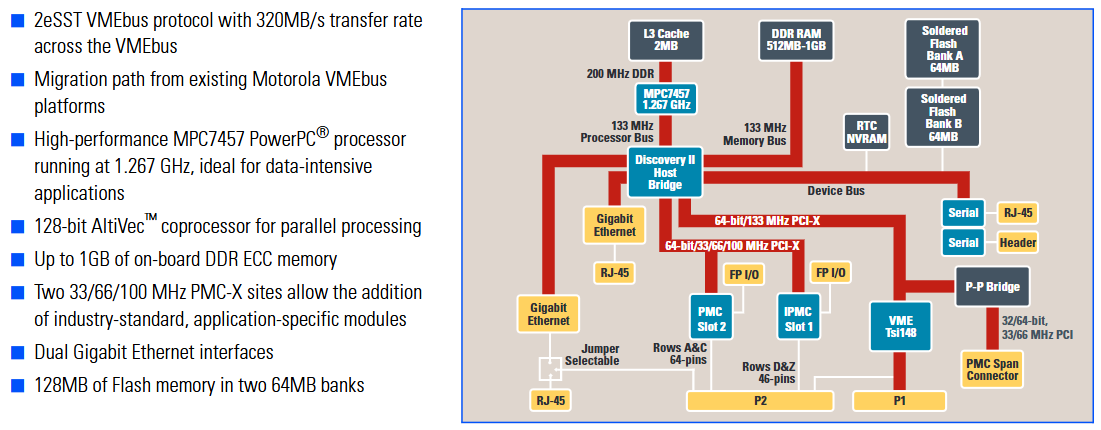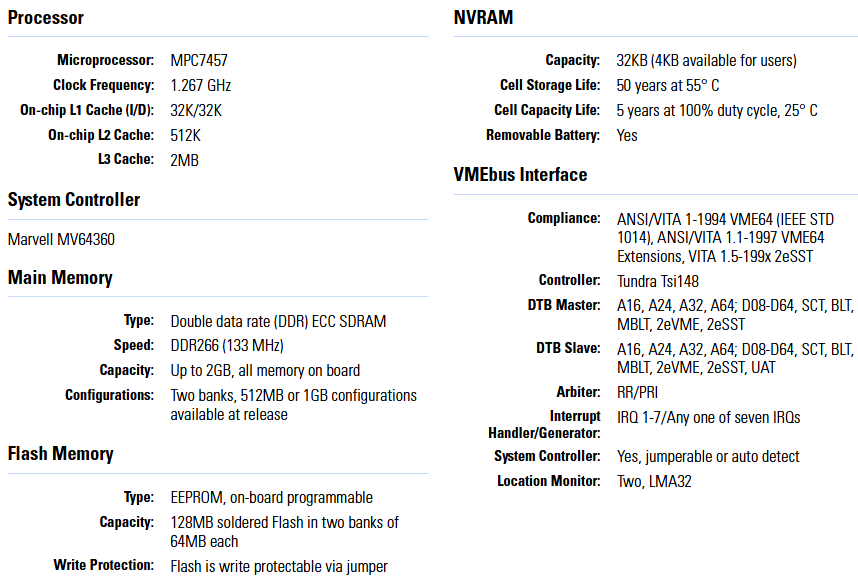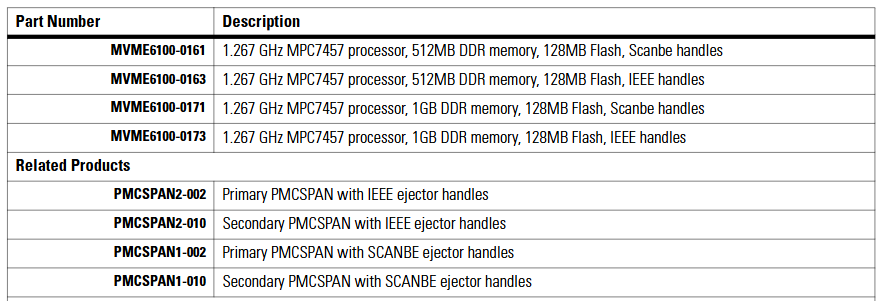

K-WANG


MOTOROLA MVME6100 series VME single board computer
Clock frequency: 1.267 GHz, suitable for data intensive applications
Cache system:
Level 1 (L1) cache: 32KB instruction cache+32KB data cache
Level 2 (L2) cache: 512KB (on-chip)
Level 3 cache: 2MB (onboard)
System bus: 133 MHz processor bus, matching processor performance to avoid bus bottlenecks
MOTOROLA MVME6100 series VME single board computer
Core hardware configuration and performance
1. Processor and cache
Equipped with high-performance MPC7457 PowerPC ® Processor, integrated with 128 bit AltiVec ™ Coprocessor (supporting parallel processing, suitable for vector operation scenarios), with the following core parameters:
Clock frequency: 1.267 GHz, suitable for data intensive applications
Cache system:
Level 1 (L1) cache: 32KB instruction cache+32KB data cache
Level 2 (L2) cache: 512KB (on-chip)
Level 3 cache: 2MB (onboard)
System bus: 133 MHz processor bus, matching processor performance to avoid bus bottlenecks
2. Memory and Storage
Main memory:
Type: Double Data Rate (DDR) ECC SDRAM, supports error checking, improves data reliability
Speed: DDR266 (133 MHz memory bus)
Capacity: Up to 2GB onboard, initially available in two configurations of 512MB/1GB (divided into two memory banks)
Flash memory:
Type: onboard programmable EEPROM, supporting jumper write protection
Capacity: 128MB (divided into two 64MB banks, soldered package, higher stability)
Non volatile memory (NVRAM):
Capacity: 32KB (4KB available for users), equipped with replaceable battery backup
Lifespan: 50 years for storage at 55 ° C, 5 years for use at 25 ° C and 100% duty cycle
Real time clock (TOD): using ST (SGS Thompson) M4T28 device to ensure time synchronization
3. VMEbus and Core Architecture
VMEbus protocol: Supports 2eSST (Two Edge Source Synchronous Transfer) protocol, with an actual transfer rate of 320MB/s, which is 8 times higher than traditional VMEbus; Simultaneously compatible with legacy protocols such as ANSI/VITA 1-1994 VME64 and VITA 1.1-1997 extensions
Interface chip: using Tundra Tsi148 ™ VMEbus interface chip, paired with Texas Instruments' new VMEbus transceiver, supports operation in standard VMEbus backboards, achieving compatibility with existing VME boards and chassis
Host Bridge: Marvel MV64360 Discovery II Host Bridge, supports 133 MHz host bus and 133 MHz DDR memory bus, and provides dual 133 MHz PCI-X buses to connect VME interface chips and PMC expansion slots respectively, ensuring balanced performance of various subsystems

I/O interface and scalability
1. Basic I/O interface
Ethernet:
Controller: Gigabit Ethernet controller integrated into the host bridge, dual interface design
Speed: 10/100/1000 Mb/s adaptive
Connection: One fixed front end (RJ-45), the other can be front end or switched through the P2 interface (10/100 Mb/s routing to MVME761 RJ-45 in IPMC mode, gigabit routing to P2 in PMC mode)
Asynchronous serial port:
Controller: ST16C554DCQ64 (compatible with 16550)
Quantity: 2, supporting EIA-574 DTE configuration
Speed: up to 38.4 Kbps (EIA-232 standard), 115 Kbps (raw mode)
Connection: one front-end (RJ-45), one for development and debugging (onboard header)
Timer: 4 32-bit programmable real-time timers/counters, 1 watchdog timer (timeout triggers system reset, improves system stability)
2. PMC expansion capability
PMC slot: Dual IEEE P1386.1 compatible with PMC-X slot, supporting the following features:
Bus specifications: 32/64 bit address/data, PCI bus frequency 33/66/100 MHz
Power supply:+3.3V,+5V, ± 12V, compatible with 3.3V/5V signals
Module type: Supports 2 single width or 1 dual width PMC/PrPMC (processor PMC) modules, expandable with additional PowerPC processors to achieve multi processor architecture
PCI Expansion: Provides 32/64 bit, 33/66 MHz PCI expansion connectors (114 pins, compatible with MVME5500 position), supports Motorola PMCSpan and other PCI expansion carriers, further expanding I/O capabilities
3. P2 I/O mode and compatibility module
Dual mode configuration: Supports PMC and IPMC P2 I/O modes through jumper cables, continuing the MVME5100/5500 series design and reducing user migration costs:
PMC mode: compatible with MVME2300/2400, MVME5100/5500, P2 interface provides 64 pins for PMC slot 1 and 46 pins for rear I/O in slot 2
IPMC mode: IPMC761/712 modules need to be installed in PMC slot 1, supporting legacy MVME761/712M I/O modules (limited PMC I/O functionality). At this time, some signals in PMC slot 2 are reserved for expanding SCSI
IPMC module function: IPMC761/712 is an optional PMC module that provides rear I/O support to ensure compatibility with previous generation products such as MVME2600/2700
1 single ended Ultra Wide SCSI port
1 parallel port
4 serial ports (IPMC761: 2 asynchronous+2 synchronous/asynchronous; IPMC712: 3 asynchronous+1 synchronous/asynchronous)
Reserve 1 PMC slot for OEM customized expansion
4. Transition Modules
MVME761:
Interface: IEEE 1284 parallel port (HD-36), 10/100BaseTX Ethernet (RJ-45), 2 asynchronous serial ports (DB-9, EIA-574 DTE), 2 synchronous/asynchronous serial ports (HD-26, configurable as EIA-232/EIA-530/V.35/X.21 DCE/DCE through SIM module)
P2 adapter: 3-line adapter supports 8-bit SCSI, 5-line adapter supports 16 bit SCSI and PMC I/O
MVME712M:
Interface: Centronics is compatible with parallel ports (D-36), narrow SCSI ports (8-bit, D-50), 4 synchronous/asynchronous serial ports (DB-25, can be configured as EIA-232 DCE/LTE via jumper)
P2 adapter: 3-line adapter supports 8-bit SCSI; Dedicated 5-line adapter with expandable access to additional user-defined I/O pins for VME64
Software support
1. Firmware Monitor
Firmware name: MOTLoad, residing in Flash memory, providing core functionality:
Power on self-test (POST): comprehensive hardware diagnosis to ensure reliable startup
System initialization: Configure hardware parameters such as processor, memory, I/O interfaces, etc
Operating System Boot: Supports multiple real-time operating systems (RTOS) and kernel booting
Debugging interface: compatible with the "bug" debugging interface of Motorola's previous generation VME board, reducing development and migration costs
2. Compatible with operating systems
Supports multiple mainstream embedded operating systems, including:
Real time operating system (RTOS): Wind River VxWorks (providing board level support package BSP)
Open source system: Linux (supported by Motorola partners)
Other: Can adapt to various real-time kernels to meet the software requirements of different application scenarios

Physical and Environmental Specifications
1. Size and weight
Size: Compatible with MVME5100 series, single VME slot design:
Board height: 233.4 mm (9.2 inches)
Depth: 160.0 mm (6.3 inches)
Front panel height: 261.8 mm (10.3 inches)
Width: 19.8 mm (0.8 inches)
Maximum component height: 14.8 mm (0.58 inches)
Weight: Scanbe controller version 425 g (15 oz), IEEE controller version 468 g (16.5 oz)
2. Power supply demand
Basic power supply (excluding PMC/IPMC modules):
+5V (± 5%): Typical 8.4 A, maximum 10.2 A
If paired with MVME761 adapter module:+5V typical 9.2 A, maximum 11.2 A
IPMC module additional power supply:
IPMC761/IPMC712:+5V maximum 0.5 A,+3.3V maximum 0.75 A
3. Environmental adaptability
Temperature: Operating temperature 0 ° C to+55 ° C (requires forced air cooling), non operating temperature -40 ° C to+85 ° C
Humidity: Supports 5% -90% in both working and non working states (no condensation, NC)
Vibration: 2G RMS (20-2000 Hz random vibration) in working state, 6G RMS (20-2000 Hz random vibration) in non working state
4. Security and EMC
Safety: All printed circuit boards (PWBs) are manufactured by UL certified manufacturers with a flammability rating of 94V-0, meeting industrial safety standards
Electromagnetic compatibility (EMC):
Launch: Compliant with FCC Part 15 Subpart B (US, Class A, non residential), ICES-003 (Canada, Class A, non residential), EN55022 Class B (EU)
Immunity: Compliant with EN55024 (EU), suitable for industrial, medical and other electromagnetic environment sensitive scenarios
5. Reliability
Mean Time Between Failures (MTBF): 178403 hours (calculated according to Bellcore Standard Version 6, Method 1, Case 3), meeting the requirements of long lifecycle industrial and defense equipment
Ordering information and related products
1. Core module model
All models offer two options for the front panel: Scanbe controller (suffix - xxx1), IEEE compatible controller (suffix - xxx3), with unified core parameters (1.267 GHz MPC7457, 128MB Flash), with only differences in memory capacity:
Model Memory Capacity Panel Type
MVME6100-0161 512MB DDR Scanbe controller
MVME6100-0163 512MB DDR IEEE controller
MVME6100-0171 1GB DDR Scanbe Handle
MVME6100-0173 1GB DDR IEEE controller
2. Supporting expansion products
PMC extension carrier:
PMCSPN1-002/010: Level 1/Level 2 PMC Extension with Scanbe Pop Up Handle
PMCSP2-002/010: Level 1/Level 2 PMC Extension with IEEE Pop Up Handle
IPMC modules: IPMC761, IPMC712 (providing legacy I/O compatibility)
Adapter modules: MVME761 (with multiple serial ports, Ethernet, SCSI), MVME712M (with serial ports SCSI)
Serial Interface Module (SIM): Supports EIA-232 DCE/LTE, EIA-530 and other configurations, compatible with MVME761
3. Document support
Technical documents can be accessed through Motorola's official website( http://www.motorola.com/computer/literature )Online viewing, including board installation guides, programmer reference manuals, firmware user manuals, etc., to assist in rapid deployment and development.
Application scenarios and core values
1. Target industry scenario
Defense Aerospace: Suitable for command and control (such as shipborne shielding systems, ground fixed systems, reconnaissance aircraft systems), 320MB/s VME bandwidth, 100 MHz PMC bus eliminates traditional bottlenecks, supports multi processor expansion, and avoids the heat dissipation and I/O management difficulties of multi processor boards
Industrial Automation: Suitable for high-end scenarios such as Semiconductor Processing Equipment (SPE) and Automatic Test Equipment (ATE), AltiVec co processor supports vector computing, dual PMC slots can customize I/O, backward compatibility helps OEMs extend existing design life
Medical imaging: meets the imaging processing requirements of nuclear medicine (NM), positron emission tomography (PET), magnetic resonance imaging (MRI), CT, etc. The 2eSST protocol improves data transmission efficiency, reduces the number of required system boards, and alleviates space limitations
2. Core user value
Investment protection: Compatible with existing VME infrastructure (boards, backboards, software), providing migration paths from MVME2300/2400/2600/2700/5100/5500 to avoid duplicate investments
Balanced performance: processor, memory, VMEbus, PCI-X bus, I/O subsystem performance matching, no obvious bottlenecks, suitable for data intensive and real-time requirements
High reliability: ECC memory, write protected Flash, long-life NVRAM, high MTBF, meeting the stringent requirements for device stability in industrial, defense, and medical fields

- YOKOGAWA
- Energy Access
- Renewable Integration
- Energy Subsidies
- Energy and Water
- Net zero emission
- Energy Security
- Critical Minerals
- A-B
- petroleum
- Mine scale
- Energy and Gender
- Covid-19
- man-machine
- Reliance
- ADVANCED
- SEW
- ProSoft
- WATLOW
- Kongsberg
- FANUC
- VSD
- DCS
- PLC
- Sewage treatment
- cement
- Yaskawa
- Woodward
- BOSCH Rexroth
- MOOG
- General Electric
- American NI
- Rolls-Royce
- CTI
- Honeywell
- EMERSON
- Automobile market
- xYCOM
- Motorola
- architecture
- Industrial information
- New energy
- electricity
- Construction site
- HIMA
- ABB
- Rockwell
- Schneider Modicon
- Siemens
- MAN
- GE
- TRICONEX
- Control Wave
- ALSTOM
- AMAT
- STUDER
- KONGSBERG
- MOTOROLA
- DANAHER MOTION
- Bentley
- Galil
- EATON
- MOLEX
- Triconex
- DEIF
- B&W
- ZYGO
- Aerotech
- DANFOSS
- KOLLMORGEN
- Beijer
- Endress+Hauser
- schneider
- Foxboro
- KB
- REXROTH
- YAMAHA
- Johnson
- Westinghouse
- WAGO
- TOSHIBA
- TEKTRONIX
-
Kollmorgen S33GNNA-RNNM-00 - Brushless Servo Motor
-
Kollmorgen 6sm56-s3000-g-s3-1325 - Servo Motor
-
Kollmorgen AKM52K-CCCN2-00 - Servo Motor
-
Kollmorgen PSR3-230/75-21-202 - Power Supply
-
Kollmorgen akm24d-anc2r-00 - Servo Motor
-
Kollmorgen AKM22E-ANCNR-00 - Servo Motor
-
Kollmorgen S60300-550 - Servo Drive
-
Kollmorgen B-204-B-21 - Servomotor
-
Kollmorgen AKM21E-BNBN1-00 - Servo Motor
-
Kollmorgen TT2953-1010-B - DC Servo Motor
-
Kollmorgen pa8500 - Servo Power Supply
-
Kollmorgen BDS4A-210J-0001-207C2 - Servo Drive
-
Kollmorgen TTRB1-4234-3064-AA - DC Servo Motor
-
Kollmorgen MH-827-A-43 - Servo Motor
-
Kollmorgen AKM24D-ACBNR-OO - Servo Motor
-
Kollmorgen 00-01207-002 - Servo Disk DC Motor
-
Kollmorgen AKM21C-ANBNAB-00 - Servo Motor
-
Kollmorgen PSR3-208/50-01-003 - Power Supply
-
Kollmorgen 6SM56-S3000 - Servo Motor
-
Kollmorgen DBL3H00130-B3M-000-S40 - Servo Motor
-
Kollmorgen 6SN37L-4000 - Servo Motor
-
Kollmorgen AKM65K-ACCNR-00 - Servo motor
-
Kollmorgen 6SM56-L3000-G - Servo Motor
-
Kollmorgen AKMH43H-CCCNRE5K - Servo Motor
-
Kollmorgen PSR4/52858300 - Power Supply
-
Kollmorgen KBM-79H03-E03 - Direct Drive Rotary Motor
-
Kollmorgen AKM33E-ANCNDA00 - Servo Motor
-
Kollmorgen U9M4/9FA4T/M23 - ServoDisc DC Motor
-
Kollmorgen AKM13C-ANCNR-00 - Servo Motor
-
Kollmorgen AKM43L-ACD2CA00 - Servo Motor
-
Kollmorgen AKM54K-CCCN2-00 - Servo Motor
-
Kollmorgen M-605-B-B1-B3 - Servo Motor
-
Kollmorgen AKD-P00606-NBAN-0000 - Rotary Drive
-
Kollmorgen 6SM-37M-6.000 - Servo Motor
-
Kollmorgen A.F.031.5 - Sercos Interface Board
-
Kollmorgen 918974 5054 - Servo PWM
-
Kollmorgen U12M4 - ServoDisc DC Motor
-
Kollmorgen AKD-B00606-NBAN-0000 - Servo Drive
-
Kollmorgen MV65WKS-CE310/22PB - Servo Drive
-
Kollmorgen 65WKS-CE310/22PB - Servo Drive
-
Kollmorgen EM10-27 - Module
-
Kollmorgen S64001 - Servo Drive
-
Kollmorgen CR03200-000000 - Servo Drive
-
Kollmorgen 6SM57M-3000+G - Servo Motor
-
Kollmorgen BDS4 - Servo Drive
-
Kollmorgen AKD-P00306-NBEC-000 - Servo Drive
-
Kollmorgen AKD-B01206-NBAN-0000 - Servo Drive
-
Kollmorgen STP-57D301 - Stepper Motor
-
Kollmorgen 6SM37L-4.000 - Servo Motor
-
Kollmorgen 44-10193-001 - Circuit Board
-
Kollmorgen PRDR9SP24SHA-12 - Board
-
Kollmorgen PRD-AMPE25EA-00 - Servo Drive
-
Kollmorgen DBL3N00130-0R2-000-S40 - Servo Motor
-
Kollmorgen S406BA-SE - Servo Drive
-
Kollmorgen AKD-P00607-NBEI-0000 - Servo Drive
-
Kollmorgen AKD-P01207-NBEC-0000 - Servo Drive
-
Kollmorgen CR03550 - Servo Drive
-
Kollmorgen VSA24-0012/1804J-20-042E - Servo Drive
-
Kollmorgen N2-AKM23D-B2C-10L-5B-4-MF1-FT1E-C0 - Actuator
-
Kollmorgen 04S-M60/12-PB - Servo Drive
-
Kollmorgen H33NLHP-LNW-NS50 - Stepper Motor
-
Kollmorgen A-78771 - Interlock Board
-
Kollmorgen AKM43E-SSSSS-06 - Servo Motor
-
Kollmorgen AKD-P00607-NBEC-0000 - Servo Drive
-
Kollmorgen E21NCHT-LNN-NS-00 - Stepper Motor
-
Kollmorgen cr10704 - Servo Drive
-
Kollmorgen d101a-93-1215-001 - Motor
-
Kollmorgen BDS4A-203J-0001-EB202B21P - Servo Drive
-
Kollmorgen MCSS23-6432-002 - Connector
-
Kollmorgen AKD-P01207-NACC-D065 - Servo Drive
-
Kollmorgen CK-S200-IP-AC-TB - I/O Adapter and Connector
-
Kollmorgen CR10260 - Servo Drive
-
Kollmorgen EC3-AKM42G-C2R-70-04A-200-MP2-FC2-C0 - Actuator
-
Kollmorgen BDS5A-206-01010-205B2-030 - Servo Drive
-
Kollmorgen s2350-vts - Servo Drive
-
Kollmorgen AKM24D-ANC2DB-00 - Servo Motor
-
Kollmorgen E31NCHT-LNN-NS-01 - Stepper Motor
-
Kollmorgen PRD-0051AMPF-Y0 - Servo Board
-
Kollmorgen TB03500 - Module
-
Kollmorgen 60WKS-M240/06-PB - Servo Drive
-
Kollmorgen M21NRXC-LNN-NS-00 - Stepper Motor
-
Kollmorgen H-344H-0212 - Servo Motor
-
Kollmorgen MCSS08-3232-001 - Connector
-
Kollmorgen AKM33H-ANCNC-00 - Servo Motor
-
Kollmorgen PA-2800 - Power Supply
-
Kollmorgen MTC308C1-R1C1 - Servo Motor
-
Kollmorgen PRDR0091300Z-00 - Capacitor Board
-
Kollmorgen BDS4A-206J-0024/01502D79 - Servo Drive
-
Kollmorgen S20330-VTS - Servo Drive
-
Kollmorgen S20250-CNS - Servo Drive
-
Kollmorgen SBD2-20-1105-WO - Servo Drive Board
-
Kollmorgen M405-C-A1--E1 - Servo Motor
-
Kollmorgen PRD-PB805EDD-00 - Servo Drive
-
Kollmorgen 6SM57S-3.000-J-09-HA-IN - Servo Motor
-
Kollmorgen AKM33H-ANCNDA-00 - Servo Motor
-
Kollmorgen PCB-00030200-04 - PCB
-
Kollmorgen H22SSLB-LNN-NS-02 - Stepper Motor
-
Kollmorgen BJRL-20012-110001 - Module
-
Kollmorgen BDS4A-206J-0001404A - Servo Drive
-
Kollmorgen H-342-H-0802 - Servo Motor
-
Kollmorgen CR10561 - Servo Drive
-
Kollmorgen BDS5A-206-00010-205B2-030 - Servo Drive
-
Kollmorgen BDS5A-206-00010-207B-2-030 - Servo Drive
-
Kollmorgen mcss08-3224-001 - Connector
-
Kollmorgen M-207-B-23-B3 - Servo Motor
-
Kollmorgen PRD-0041200Z-S0 - Encoder/Resolver Card
-
Kollmorgen MH-225-G-61 - Motor
-
Kollmorgen MT308B1-T1C1 - Servo Motor
-
Kollmorgen BDS4A-240J-0001604C83 - Servo Drive
-
Kollmorgen 6SM57-S-3000 - Servo Motor
-
Kollmorgen N-T31V-15-5B-6-MF3-FT1E-C251 - Actuator
-
Kollmorgen PRD-0051AMPA-X0 - Servo Board
-
Kollmorgen CF-SS-RHGE-09 - Cable
-
Kollmorgen DIGIFAS7204 - Servo Drive
-
Kollmorgen S30101-NA - Servo Drive
-
Kollmorgen DIGIFAS7201 - Servo Drive
-
Kollmorgen PRD-0051AMPA-Y0 - Servo Board
-
Kollmorgen AKM23D-EFCNC-00 - Servo Motor
-
Kollmorgen SE10000 - Servo Drive
-
Kollmorgen PSR4/5A-112-0400 - Power Supply
-
Kollmorgen AKM31H-ANCNC-01 - Servo Motor
-
Kollmorgen M-203-B-93-027 - Servo Motor
-
Kollmorgen CP-SS-G1HE-05 - Connector
-
Kollmorgen AKM42G-ASCNR-02 - Servo Motor
-
Kollmorgen DBL4N00750-B3M-000-S40 - Servo Motor
-
Kollmorgen R3-BK23-152B-12-PL-ASE-BS115 - Actuator
-
Kollmorgen MH-427-B-61 - Motor
-
Kollmorgen cr06902 - Servo Drive




